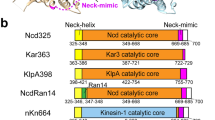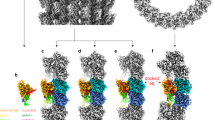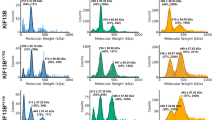Abstract
Motor proteins of the kinesin superfamily transport intracellular cargo along microtubules. Although different kinesin proteins share 30–50% amino-acid identity in their motor catalytic cores, some move to the plus end of microtubules whereas others travel in the opposite direction1,2. Crystal structures of the catalytic cores of conventional kinesin (a plus-end-directed motor involved in organelle transport) and ncd (a minus-end-directed motor involved in chromosome segregation) are nearly identical3,4; therefore, the structural basis for their opposite directions of movement is unknown. Here we show that the ncd ‘neck’, made up of 13 class-specific residues next to the superfamily-conserved catalytic core, is essential for minus-end-directed motility, as mutagenesis of these neck residues reverses the direction of ncd motion. By solving the 2.5 Å structure of a functional ncd dimer, we show that the ncd neck (a coiled-coil) differs from the corresponding region in the kinesin neck (an interrupted β-strand)5,6, although both necks interact with similar elements in the catalytic cores. The distinct neck architectures also confer different symmetries to the ncd and kinesin dimers and position these motors with appropriate directional bias on the microtubule.
This is a preview of subscription content, access via your institution
Access options
Subscribe to this journal
Receive 51 print issues and online access
$199.00 per year
only $3.90 per issue
Buy this article
- Purchase on Springer Link
- Instant access to full article PDF
Prices may be subject to local taxes which are calculated during checkout



Similar content being viewed by others
References
Hirokawa, N. Kinesin and dynein superfamily proteins and the mechanism of organelle transport. Science 279, 519–526 (1998).
Vale, R. D. & Fletterick, R. J. The design plan of kinesin motors. Annu. Rev. Cell Dev. Biol. 13, 745–777 (1997).
Kull, F. J., Sablin, E. P., Lau, R., Fletterick, R. J. & Vale, R. D. Crystal structure of the kinesin motor domain reveals a structural similarity to myosin. Nature 380, 555–559 (1996).
Sablin, E. P., Kull, F. J., Cooke, R., Vale, R. D. & Fletterick, R. J. Crystal structure of the motor domain of the kinesin-related motor ncd. Nature 380, 555–559 (1996).
Kozielski, F. et al. The crystal structure of dimeric kinesin and implications for microtubule-dependent motility. Cell 91, 985–994 (1997).
Sack, S. et al. X-ray structure of motor and neck domains from rat brain kinesin. Biochemistry 36, 16155–16165 (1997).
McDonald, H. B. & Goldstein, L. S. Identification and characterization of a gene encoding a kinesin-like protein in Drosophila. Cell 61, 991–1000 (1990).
Endow, S. A., Henikoff, S. & Soler, N. L. Mediation of meiotic and early mitotic chromosome segregation in Drosophila by a protein related to kinesin. Nature 345, 81–83 (1990).
Hirose, K., Lockhard, A., Cross, R. A. & Amos, L. A. Three-dimensional cryoelectron microscopy of dimeric kinesin and ncd motor domains on microtubules. Proc. Natl Acad. Sci. USA 93, 9539–9544 (1996).
Arnal, I., Metoz, F., DeBonis, S. & Wade, R. H. Three-dimensional structure of functional motor proteins on microtubules. Curr. Biol. 6, 1265–1270 (1996).
Sosa, H. et al. Amodel for the microtubule-Ncd motor protein complex obtained by cryo-electron microscopy and image analysis. Cell 90, 217–224 (1997).
Amos, L. A. & Hirose, K. The structure of microtubule–motor complexes. Curr. Opin. Cell Biol. 9, 4–11 (1997).
Woehlke, G. et al. Microtubule interaction site of the kinesin motor. Cell 90, 207–216 (1997).
Henningsen, U. & Schliwa, M. Reversal in the direction of movement of a molecular motor. Nature 389, 93–96 (1997).
Case, R. B., Pierce, D. W., Hom-Booher, N., Hart, C. L. & Vale, R. D. The directional preference of kinesin motors is specified by an element outside of the motor catalytic domain. Cell 90, 959–966 (1997).
Rost, B. & Sander, C. PHD: predicting one-dimensional protein structure by profile based neural networks. Methods Enzymol. 266, 525–539 (1996).
Lupas, A., Van Dyke, M. & Stock, J. Predicting coiled coils from protein sequences. Science 252, 1162–1164 (1991).
Walker, R. A., Salmon, E. D. & Endow, S. A. The Drosophila claret segregation protein is a minus-end directed motor molecule. Nature 347, 780–782 (1990).
Brunger, A. T. X-PLOR Version 3.1. A System for X-ray Crystallography and NMR (Yale Univ. Press, New Haven, (1992)).
Kodama, T., Fukui, K. & Kometani, K. The initial phosphate burst in ATP hydrolysis by myosin and subfragment 1 as studied by a modified Malachite Green method for determination of organic phosphate. J. Biochem. 99, 1465–1472 (1986).
Hyman, A. A. Preparation of marked microtubules for the assay of the polarity of microtubule-based motors by fluorescence. J. Cell Sci. Suppl. 14, 125–127 (1991).
Acknowledgements
We thank M. Matuska for technical assistance, and J. Somoza and C. Sindelar for comments on manuscript. E.P.S. was supported by a postdoctoral fellowship from the Leukemia Society of America. This work was supported in part by a program project grant from the NIH.
Author information
Authors and Affiliations
Corresponding author
Rights and permissions
About this article
Cite this article
Sablin, E., Case, R., Dai, S. et al. Direction determination in the minus-end-directed kinesin motor ncd. Nature 395, 813–816 (1998). https://doi.org/10.1038/27463
Received:
Accepted:
Issue Date:
DOI: https://doi.org/10.1038/27463
This article is cited by
-
Anchoring geometry is a significant factor in determining the direction of kinesin-14 motility on microtubules
Scientific Reports (2022)
-
Directionality of dynein is controlled by the angle and length of its stalk
Nature (2019)
-
Kinesins: Motor Proteins as Novel Target for the Treatment of Chronic Pain
Molecular Neurobiology (2019)
-
A rice class-XIV kinesin enters the nucleus in response to cold
Scientific Reports (2018)
-
The mitotic kinesin-14 KlpA contains a context-dependent directionality switch
Nature Communications (2017)
Comments
By submitting a comment you agree to abide by our Terms and Community Guidelines. If you find something abusive or that does not comply with our terms or guidelines please flag it as inappropriate.



